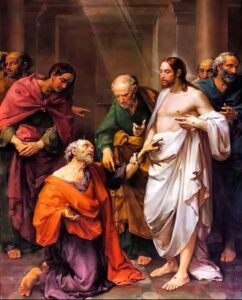Our Heavenly Patron
St. Thomas the Apostle
 Thomas (Te’oma in Aramaic) also called Didymus (in Greek) mean “Twin.” Early church traditions state that he had a twin sister Lydia, but in Syriac tradition he is called Judas Thomas as the twin brother of Jesus. He is called Judas Thomas (i.e., Judas the Twin) by the Syrians. Thomas probably was born in Galilee, city of Pansada. Scripture suggests that he was a fisherman, not a full-fledged owner but a helper. The Acts of Thomas suggests that Thomas was a carpenter and a member of Jesus’ immediate family. Legend places that Thomas was an architect.
Thomas (Te’oma in Aramaic) also called Didymus (in Greek) mean “Twin.” Early church traditions state that he had a twin sister Lydia, but in Syriac tradition he is called Judas Thomas as the twin brother of Jesus. He is called Judas Thomas (i.e., Judas the Twin) by the Syrians. Thomas probably was born in Galilee, city of Pansada. Scripture suggests that he was a fisherman, not a full-fledged owner but a helper. The Acts of Thomas suggests that Thomas was a carpenter and a member of Jesus’ immediate family. Legend places that Thomas was an architect.
He was the first one of the Twelve to enter the Gospels practically unnoticed. The first seven apostles had been mentioned before their calling, but Thomas’ name appears for the first time in the lists of the apostles. St. John recorded a few very significant words about Thomas in three passages; these words reveal the whole nature of Thomas. First, when Jesus announced His intention of returning to Judea to visit Lazarus, “Thomas” who is called Didymus, said to his fellow disciples: “Let us also go, that we may die with him” (Jn 11:16). Second, the discourse before the Last Supper raised an objection: Thomas said to him: “Lord, we do not know where you are going; how can we know the way?” And Jesus answered Thomas: “I am the way, and the truth, and the life.” (Jn 14:5). Third, Thomas makes that historical confession as, “My Lord and my God!” (Jn20:27-28).His sudden realization of truth made Thomas the first person to explicitly acknowledge Jesus’ divinity.
The apostle Thomas, after our Lord’s ascension, continued to preach the gospel in various parts of Judaea at length, until being interrupted by the dispersion of the Christian church in Jerusalem, he repaired into Parthia. Leaving Persia, he traveled into Ethiopia, preaching the glad tidings of the gospel, healing the sick, and working other miracles, to prove he had his commission from on high. According to the Acts of Judas Thomas, the Apostle Thomas first came from Jerusalem with Habban, the merchant of King Gundaphor to Alexandria, Aden and Sokotra and from there to Barygaza (Bharukaccha), Gujarat, India in 44 – 48 AD. After the Jerusalem council (AD 50) Thomas decided to come back to India for continuing his missionary works. But in 51 AD the Parthian King Gundaphoras died; and the Kushans attacked his Kingdom. So, St. Thomas took the sea route through Alexandria, Aden, Sokotra to Muziris (Kodungallur) and in the year 52 AD St. Thomas arrived in Muziris (Kodungalloor) which was then called Maliankara.
Thomas has preached the gospel throughout India especially the Malabar coast, though the various churches he founded were located mainly on the Periyar River and its tributaries and along the coast, where there were Jewish colonies. He reputedly preached to all classes of people and had about seventeen thousand converts, including members of the four principal castes.
Saint Thomas became a martyr in 72 AD. There are different traditions regarding his death. The traditions of Malabar, Coromandel and the Persian Church held that Thomas the Apostle died near the ancient town of Mylapore in Madras. After he was killed at Little Mount (Chinnamala) his body was brought to Mylapore and buried inside the church he had built there.
Now, feast day of St. Thomas in Roman and Syrian Catholic churches is on 3rd July. In addition, the next Sunday of the Easter (Pascha) is celebrated as Sunday of Thomas, in commemoration of Thomas’ question to Jesus which led him to proclaim, ‘My Lord and My God’ and the day in Kerala is known as Puthunjayar. Thomas is also commemorated in common with all of the other apostles on June 30, in a feast called the Synaxis of the Holy Apostles. Thomas is considered to be the patron saint of architects, builders, carpenters, construction workers, geometricians, masons, stone masons, stone cutters, surveyors, theologians, people who have doubts in faith and blind.
